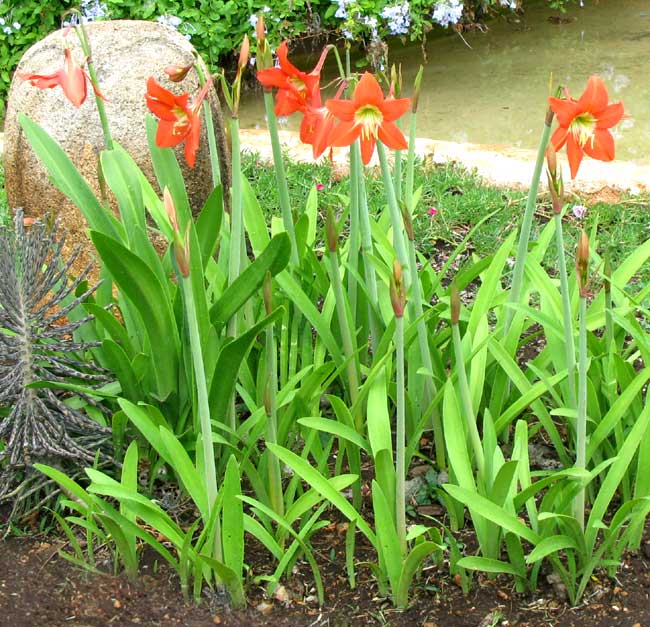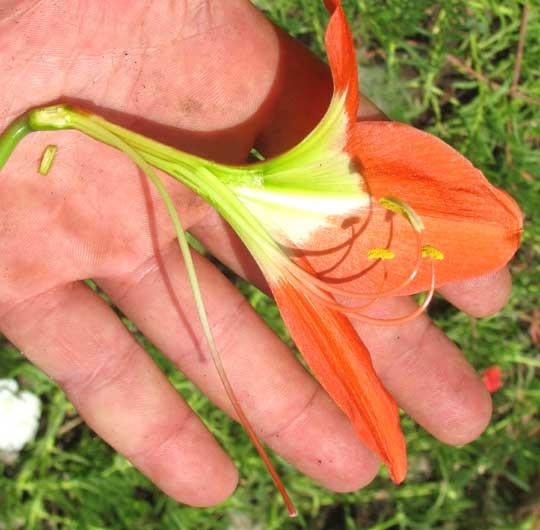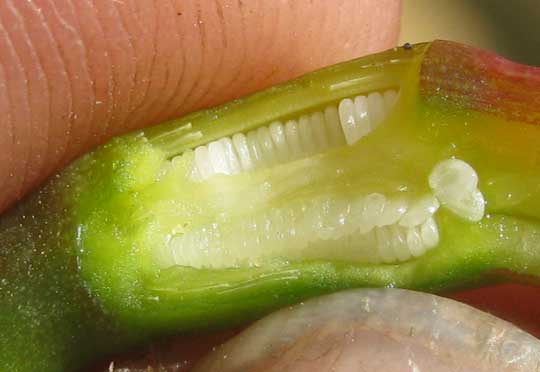Excerpts from Jim Conrad's
Naturalist Newsletter

from the April 10, 2011 Newsletter issued from Hacienda Chichen Resort beside Chichén Itzá Ruins, central Yucatán, MÉXICO; limestone bedrock, elevation ~39m (~128ft), ~N20.676°, ~W88.569°
BARBADOS LILY
At Hacienda Chichen's entrance a small gathering of knee-high garden flowers bearing clusters of nodding, orange-red blossoms is flowering nowadays, as seen above. With so many websites dedicated to garden flowers, I thought that finding a name for our plants would be a simple matter of running a Google image-search on the keywords "orange amaryllis," then matching a resulting thumbnail picture with our flowers. However, it turned out to be harder than that.
First of all, I recognized the plants as amaryllises by their large, colorful, fleshy blossoms arising in clusters atop stiff, hollow stems, or "scapes." Also, stems and leaves arose from bulbs, which could be felt with fingers probing in the soil at the plants' bases. Similarly it was "typical amaryllis" how the plants' orange perianths (undifferentiated calyxes and corollas) were funnel shaped, with long, recurving stamens attached high on the funnels' walls, not atop the ovaries. An opened flower showing this is shown below:

In that picture you can also see the oval ovary atop which the perianth arises, at the far left of my hand. A close-up showing ovules in the opened ovary is below:

All that was pretty straightforward. The challenge arose trying to match our Hacienda plants with a Google-found, identified amaryllis.
One problem was that the vast majority of plants I've always thought of as amaryllises turn out to be members of the genus Hippeastrum. The genus Amaryllis does exist, but it's much less represented in Nature and gardens than Hippeastrum. How this confusion arose is too complicated to dwell on.
A second reason it was hard to match a picture is that the genus Hippeastrum, native mostly to Mexico and South America, embraces about 90 species, from which more than 600 hybrids and cultivars have been developed.
Still, just by matching pictures, it looks like what we have here at Hacienda Chichen is what's known as the Barbados Lily -- even though it's not a lily -- with the binomial Hippeastrum puniceum. It appears that our plants may have little or no hybridization in their histories, and thus may be pure or almost-pure representatives of the original parent species. Most Hippeastrum species are disappearing in the wild.
In fact, nowadays among serious gardeners there's a sort of backlash taking place, whereby the old, relatively plain-looking Mexican and South American "species" -- not-hybridized or perpetuated mutants -- are "rescued" by being planted instead of the gaudy, gene-manipulated, miniature-poodle-like flowers flooding the market today.